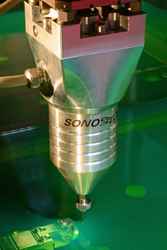
Posted to News on 4th Jul 2014, 10:01
Piezo actuators accelerate microstructuring for die-sinking EDM
Actuators based on the piezo effect move heavy loads with resolutions in the sub-nanometre range and response times below one millisecond, enabling dynamic operation at high scanning frequencies. Moreover, since they have no moving parts in the conventional sense, piezo actuators are not only very reliable, but also are maintenance free. Diverse applications, ranging from medical and metering technology, to photonics, semiconductor technology, automation and production technology benefit from these characteristics. In all these applications, piezoceramic actuators contribute to advances in technology. For example, when die-sinking EDM is used to produce precision components, piezo actuators help to drastically reduce production times.

The increasing complexity of products and processes requires production processes to constantly increase throughput, precision, geometric diversity and accurate repeatibility. At the same time, the trend in automation is toward miniaturisation, so it is hardly surprising that in the field of die-sinking EDM, microstructured precision components are now manufactured, often in large piece quantities. Examples include the manufacture of filter elements or injection nozzles for the automotive industry. This in turn drives the need for economising the production processes associated with microstructuring: cost and resource efficiency play important roles in this context.
This topic has been taken up by the Institute for Microtechnology in Mainz (ICT-IMM), which has become part of the Fraunhofer Gesellschaft in 2014. The Sonodrive 300 is a serial-production vibratory spindle which, in high-precision microdrilling operations, can cut machining times by up to 60 per cent compared with standard equipment, employing a patented process. The spindle rotates and vibrates simultaneously, preventing the particles produced in EDM from being deposited in the hole, thereby eliminating the need to machine them again. In conventional methods this is unavoidable, because the small electrode distances do not allow any flushing in the micrometer range. Depending on the material to be machined and the job at hand, the vibration path can be set and adjusted at any time during the process.
Compared with conventional methods, this delivers substantial speed benefits, accelerating the entire production process. With a 0.2mm diameter blind hole in 1.0mm-thick VA material, the machining time in a test on a EA12 die-sinking EDM machine from Mitsubishi Electric was reduced from 200 to slightly below 80 seconds. On an Agie Compact die-sinking EDM machine, the time for a 0.2mm diameter through-hole in 0.4mm thick VA material was 60 per cent faster through the use of a vibratory spindle. The new spindle principle combines high concentricity tolerance of 1-2um absolute at a revolution of up to 3500min-1 with a high-frequency vibration of max. 300Hz and a stroke of up to 15um. The spindle fits all commercially available die-sinking EDM machines as a "Plug & Play" system. The matching miniaturised wire pay-off device, likewise developed by ICT-IMM, can also be easily integrated. This allows the concentricity tolerance to be reduced to 1um absolute.
Piezo actuator ensures vibration
This technological leap for microstructuring has been achieved by combining expertise and components of high technical quality. A piezo actuator from Physik Instrumente (PI) ensures vibration. There are several good reasons why PI was chosen. The creation of vibrations is a classic piezo application, because the piezo element starts to oscillate when an AC voltage is applied. This means that piezo actuators convert voltage directly into mechanical displacement. They achieve typical travel ranges of a few hundred micrometers and high dynamics, with frequencies of up to several hundred hertz. The short response times of the piezos also benefit the application as a vibration drive. With its height of 25mm at a diameter of 50mm and its inner aperture of 25mm, the selected actuator could be easily integrated in the vibratory spindle.
Since piezos are also suitable for large loads, the permanent motion of the spindle, whose weight varies between about 250 and 450g, depending on the electrode, was no problem for the small drive. If need be, it can lift more than 1kg. In contrast, electromechanical components for vibration generation were not an option for this application: because of their structure and larger dimensions, it would not have been possible to integrate them into a useful unit for practical use.
There are further arguments for the use of piezos: since the motion is based on crystalline solid-state effects, there is no danger of abrasion with this technology and there are no cogwheels, bearings or other mechanical parts subject to wear. This makes the piezo actuator maintenance free. This is an important characteristic, given that the piezo actuator operates throughout the entire machining operation. It has already proven its reliability, for example, in a prototype vibratory spindle, which has been operating at ICT-IMM for about 4 years, where it has by now completed approximately 100 million operating cycles.
The piezo actuator is driven by an efficient, pulse-width-modulated high-power voltage amplifier, also from PI. This amplifier is designed for the demands of low-voltage piezo actuators. At a peak output power of up to 280W and an average output power of up to 100W, it can supply and consume a peak current of up to 2000mA. This allows dynamic operation of piezo actuators of high capacity at a bandwidth up to the kilohertz range, more than is required for micro EDM.
A vibration-supported electrode chuck also saves time
Piezo actuators have also been tested and proven in a vibration-supported electrode chuck, which is also suitable as "Plug & Play" system for all commercially available die-sinking EDM machines and clamping systems, and has a compact structure of 80 × 80 × 150mm. Here, too, the 300Hz vibrations at an adjustable stroke of up to 15um accelerate the production process considerably: a long-term experiment with a hard-metal electrode (0.2 × 5mm) and a sinking depth of 7mm resulted in a time saving of 70 per cent. Production time was reduced from 17 hours and 20 minutes to 5 hours and 15 minutes. This can benefit many areas of application. Typical examples are micromachining, tool-making and mould-making, and the manufacture of components for medical technology, metrology and machine technology. Piezo actuators used as vibration generators have thus made a substantial contribution to advancing the technology of die-sinking EDM to the lowest micrometer range.
To learn more about piezo actuators, please visit www.pi.ws.
Trent House, University Way
Cranfield Technology Park
MK43 0AN
UNITED KINGDOM
+44 (0)1234 756360






























